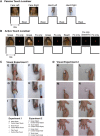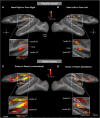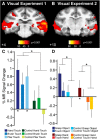Functional MRI Responses to Passive, Active, and Observed Touch in Somatosensory and Insular Cortices of the Macaque Monkey
- PMID: 29540550
- PMCID: PMC6705905
- DOI: 10.1523/JNEUROSCI.1587-17.2018
Functional MRI Responses to Passive, Active, and Observed Touch in Somatosensory and Insular Cortices of the Macaque Monkey
Abstract
Neurophysiological data obtained in primates suggests that merely observing others' actions can modulate activity in the observer's motor cortices. In humans, it has been suggested that these multimodal vicarious responses extend well beyond the motor cortices, including somatosensory and insular brain regions, which seem to yield vicarious responses when witnessing others' actions, sensations, or emotions (Gazzola and Keysers, 2009). Despite the wealth of data with respect to shared action responses in the monkey motor system, whether the somatosensory and insular cortices also yield vicarious responses during observation of touch remains largely unknown. Using independent tactile and motor fMRI localizers, we first mapped the hand representations of two male monkeys' primary (SI) and secondary (SII) somatosensory cortices. In two subsequent visual experiments, we examined fMRI brain responses to (1) observing a conspecific's hand being touched or (2) observing a human hand grasping or mere touching an object or another human hand. Whereas functionally defined "tactile SI" and "tactile SII" showed little involvement in representing observed touch, vicarious responses for touch were found in parietal area PFG, consistent with recent observations in humans (Chan and Baker, 2015). Interestingly, a more anterior portion of SII, and posterior insular cortex, both of which responded when monkeys performed active grasping movements, also yielded visual responses during different instances of touch observation.SIGNIFICANCE STATEMENT Common coding of one's own and others' actions, sensations, and emotions seems to be widespread in the brain. Although it is currently unclear to what extent human somatosensory cortices yield vicarious responses when observing touch, even less is known about the presence of similar vicarious responses in monkey somatosensory cortex. We therefore localized monkey somatosensory hand representations using fMRI and investigated whether these regions yield vicarious responses while observing various instances of touch. Whereas "tactile SI and SII" did not elicit responses during touch observation, a more anterior portion of SII, in addition to area PFG and posterior insular cortex, all of which responded during monkeys' own grasping movements, yielded vicarious responses during observed touch.
Keywords: fMRI; grasping; macaque; motor; somatosensory; touch.
Copyright © 2018 the authors 0270-6474/18/383689-19$15.00/0.
Figures












Similar articles
-
Embodied empathy for tactile events: Interindividual differences and vicarious somatosensory responses during touch observation.Neuroimage. 2012 Apr 2;60(2):952-7. doi: 10.1016/j.neuroimage.2012.01.112. Epub 2012 Jan 28. Neuroimage. 2012. PMID: 22306799
-
Seeing is not feeling: posterior parietal but not somatosensory cortex engagement during touch observation.J Neurosci. 2015 Jan 28;35(4):1468-80. doi: 10.1523/JNEUROSCI.3621-14.2015. J Neurosci. 2015. PMID: 25632124 Free PMC article.
-
Motor resonance in monkey parietal and premotor cortex during action observation: Influence of viewing perspective and effector identity.Neuroimage. 2021 Jan 1;224:117398. doi: 10.1016/j.neuroimage.2020.117398. Epub 2020 Sep 22. Neuroimage. 2021. PMID: 32971263
-
Predictive coding accounts of shared representations in parieto-insular networks.Neuropsychologia. 2015 Apr;70:442-54. doi: 10.1016/j.neuropsychologia.2014.10.020. Epub 2014 Oct 24. Neuropsychologia. 2015. PMID: 25447372 Review.
-
Parallel organization of somatosensory cortical areas I and II for tactile processing.Clin Exp Pharmacol Physiol. 1996 Oct-Nov;23(10-11):931-8. doi: 10.1111/j.1440-1681.1996.tb01145.x. Clin Exp Pharmacol Physiol. 1996. PMID: 8911737 Review.
Cited by
-
Shared neural representations of tactile roughness intensities by somatosensation and touch observation using an associative learning method.Sci Rep. 2019 Jan 11;9(1):77. doi: 10.1038/s41598-018-37378-w. Sci Rep. 2019. PMID: 30635598 Free PMC article.
-
No Evidence for Cross-Modal fMRI Adaptation in Macaque Parieto-Premotor Mirror Neuron Regions.Brain Sci. 2023 Oct 17;13(10):1466. doi: 10.3390/brainsci13101466. Brain Sci. 2023. PMID: 37891833 Free PMC article.
-
Mirror neurons are modulated by grip force and reward expectation in the sensorimotor cortices (S1, M1, PMd, PMv).Sci Rep. 2021 Aug 5;11(1):15959. doi: 10.1038/s41598-021-95536-z. Sci Rep. 2021. PMID: 34354213 Free PMC article.
-
Sensorimotor processing is dependent on observed speed during the observation of hand-hand and hand-object interactions.Psychol Res. 2023 Sep;87(6):1806-1815. doi: 10.1007/s00426-022-01776-7. Epub 2022 Dec 14. Psychol Res. 2023. PMID: 36515698
-
Research Progress on Neural Processing of Hand and Forearm Tactile Sensation: A Review Based on fMRI Research.Neuropsychiatr Dis Treat. 2025 Jan 31;21:193-212. doi: 10.2147/NDT.S488059. eCollection 2025. Neuropsychiatr Dis Treat. 2025. PMID: 39906284 Free PMC article. Review.
References
-
- Bremmer F, Schlack A, Shah NJ, Zafiris O, Kubischik M, Hoffmann K, Zilles K, Fink GR (2001) Polymodal motion processing in posterior parietal and premotor cortex: a human fMRI study strongly implies equivalencies between humans and monkeys. Neuron 29:287–296. 10.1016/S0896-6273(01)00198-2 - DOI - PubMed
Publication types
MeSH terms
LinkOut - more resources
Full Text Sources
Other Literature Sources
